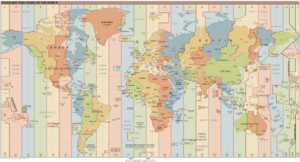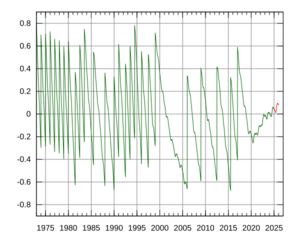Coordinated Universal Time facts for kids
Coordinated Universal Time (UTC) is the main way we keep track of time all over the world. Think of it as the master clock that helps everyone stay on the same schedule. It sets the official time for time zones and helps with things like international calls, flying planes, and even science experiments.
Most countries use UTC. It's like the modern version of Greenwich Mean Time (GMT). UTC helps us coordinate everything, from sending messages across oceans to launching rockets.
UTC uses super-accurate atomic clocks from all over the globe to measure time. It stays very close to the sun's position at the prime meridian (0° longitude). UTC itself does not change for daylight saving time.
UTC became an official standard in 1963. Its abbreviation, "UTC," was chosen in 1967. The International Telecommunication Union helps manage how UTC works today.
Over the years, UTC has been adjusted with special "leap seconds." These are extra seconds added to keep our clocks in sync with the Earth's rotation. Recently, there have been talks about stopping these leap seconds because they can sometimes cause problems for computer systems. In 2022, a big meeting called the General Conference on Weights and Measures decided to change UTC. They plan to remove leap seconds by 2035.
Contents
Where Does the Name UTC Come From?
The official short name for Coordinated Universal Time is UTC. This abbreviation was chosen because different groups, like the International Telecommunication Union and the International Astronomical Union, wanted a name that could be used easily in all languages.
They agreed on "UTC" because it fit with other similar time abbreviations, like UT1 and UT2. This way, everyone could use the same simple abbreviation.
How UTC is Used Around the World
UTC is super important for how we organize time globally. It helps us keep track of different time zones.
Time Zones and UTC Offsets
Every time zone is set by adding or subtracting hours from UTC. For example, some places are 5 hours behind UTC, while others might be 8 hours ahead. This is called a UTC offset.
The time zones stretch from 12 hours behind UTC in the west to 14 hours ahead in the east. This wide range helps cover all parts of the globe.
UTC in Everyday Life
UTC is used a lot on the Internet and the World Wide Web. When your computer's clock syncs up, it often uses UTC. This makes sure that websites and online services work correctly, no matter where you are.
Pilots and air traffic control also use UTC for all their plans and communications. They often call it "Zulu time." This helps prevent confusion when planes fly across many time zones.
Weather forecasts and maps use UTC too. This way, everyone knows exactly when a weather event is expected, without worrying about local time changes. Even astronauts on the International Space Station use UTC!
People who enjoy amateur radio use UTC to plan their calls. This is because their radio signals can travel very far, reaching people in many different time zones.
On electronic devices, if you need to set the time zone to UTC, you can often choose cities like Accra in Ghana or Reykjavík in Iceland. These cities always stay on UTC and do not use daylight saving time.
What About Daylight Saving Time?
UTC itself never changes. It stays the same all year round. However, the local time in many places does change when Daylight Saving Time (also called summer time) begins or ends.
For example, a city might be 5 hours behind UTC in winter. But when Daylight Saving Time starts, it might become 4 hours behind UTC. This is why UTC is so useful: it's a constant reference point that doesn't shift with the seasons.
How UTC Works: Seconds and Leap Seconds
UTC organizes time into days, hours, minutes, and seconds. We use the Gregorian calendar to keep track of the days.
Each day has 24 hours, and each hour has 60 minutes. Usually, a minute has 60 seconds. But sometimes, we add an extra second, called a leap second. This means a minute can sometimes have 61 seconds. It's also possible for a minute to have 59 seconds, but this has not happened yet.
The Earth's Rotation and Time
The Earth's rotation isn't perfectly steady. It can speed up or slow down a tiny bit. Because of this, the time based on the Earth's rotation (called UT1) can slowly drift away from the super-accurate time kept by atomic clocks (called International Atomic Time or TAI).
To keep UTC very close to the Earth's actual rotation, we sometimes add a leap second. This extra second helps our clocks stay in sync with the sun's position. These leap seconds are usually added at the end of June or December.
Scientists at the International Earth Rotation and Reference Systems Service decide when a leap second is needed. They announce it about six months in advance. We can't predict these leap seconds too far into the future because the Earth's rotation is a bit unpredictable.
For very precise measurements, like those used in space missions, scientists sometimes use TAI instead of UTC. This is because TAI doesn't have leap seconds, making it a smoother, more consistent time scale. GPS time also uses a system similar to TAI, without leap seconds.
The History of UTC
Before UTC, people used something called Universal Time (UT). This was based on the Earth's rotation.
The Invention of Atomic Clocks
In 1955, a super accurate atomic clock was invented. These clocks were much more stable than relying on how fast the Earth spun. Scientists in the U.S. and the UK started using these clocks to create new, very precise time scales.
Around 1960, these groups began working together. They coordinated their radio time signals. This new, coordinated time system was informally called "Coordinated Universal Time."
At first, they tried to keep this new time system in sync with the Earth's rotation by making small adjustments. But it was decided that it was better to have a consistent second, based on atomic clocks.
Introducing Leap Seconds
In 1968, scientists suggested that instead of tiny, frequent adjustments, they should use bigger, 1-second adjustments. This idea led to the creation of leap seconds.
The system we use today, with leap seconds, was officially put into place in 1972. Since then, UTC has been based on International Atomic Time (TAI), which comes from many atomic clocks. Leap seconds are added as needed to keep UTC within 0.9 seconds of the Earth's rotation time (UT1).
How Many Leap Seconds Have There Been?
The very first leap second was added on June 30, 1972. Since then, leap seconds have been added about once every 19 months. They always happen on June 30 or December 31.
As of September 2025, there have been 27 leap seconds in total. All of them have been "positive," meaning an extra second was added. This makes UTC 37 seconds behind TAI.
A study in March 2024 found that the melting of ice in places like Greenland and Antarctica is actually slowing down the Earth's spin. This affects how UTC needs to be adjusted and can cause issues for computer systems that depend on super-accurate time.
Why Leap Seconds Are Needed
The Earth's rotational speed is actually slowing down very, very gradually. This means that a day, based on the sun, is getting a tiny bit longer over time.
Our modern SI second, which is used in UTC, is based on how long a second was in the mid-1800s. Since then, the Earth's day has become slightly longer than 86,400 SI seconds.
Because the Earth's day is a little longer, UTC (which uses constant SI seconds) would slowly get ahead of the actual sun time. To fix this, we add a leap second. This extra second helps UTC stay aligned with the Earth's slower rotation.
It's like adding a leap year day every four years to keep our calendar in sync with the Earth's orbit around the sun. Leap seconds do a similar job for our daily clocks and the Earth's spin. The Earth's rotation isn't perfectly smooth; things like plate tectonics can affect it, so scientists have to constantly observe it.
The Future of UTC: No More Leap Seconds?
Scientists have been discussing the future of leap seconds for a while. As the Earth's rotation continues to change, we would need to add leap seconds more and more often. This could cause problems for many computer systems.
Interestingly, around June 2019, the Earth's rotation actually sped up a bit. This meant that instead of needing more positive leap seconds, there was a discussion about whether a "negative" leap second might be needed. A negative leap second would mean removing a second, but this has never happened before. As of September 2025, a negative leap second has not been needed.
Plans to End Leap Seconds
In 2022, a major decision was made by the General Conference on Weights and Measures. They adopted a plan to change UTC and stop using leap seconds by 2035.
This means that while our clocks will continue to tick at a steady rate based on atomic time, they will slowly drift away from the exact position of the sun in the sky. It's similar to how our calendar year doesn't perfectly match the Earth's orbit, causing the seasons to shift slightly over thousands of years.
This change will mean that UTC will no longer be perfectly linked to the Earth's exact geographic position. Over many centuries, the difference between UTC and the sun's position could become quite large.
In late 2023, the ITU World Radiocommunication Conference (WRC-23) officially supported this plan. They confirmed that the maximum difference between UTC and the Earth's rotation time (UT1) will be increased by 2035.
See also
 In Spanish: Tiempo universal coordinado para niños
In Spanish: Tiempo universal coordinado para niños
- Coordinated Lunar Time
- Coordinated Mars Time (MTC)
- Ephemeris time
- IERS Reference Meridian
- ISO 8601
- ITU-R
- List of UTC timing centers
- Terrestrial Time
- Universal Time
- World Radiocommunication Conference



